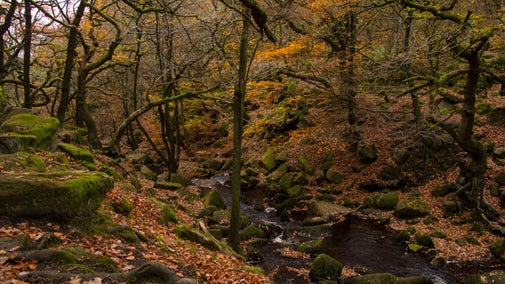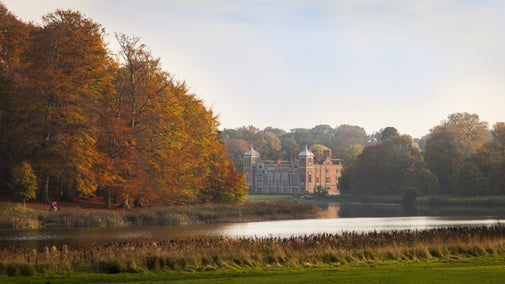
Adopt a Plot
Adopt a Plot today and together, we can welcome back our natural landscapes, one plot at a time.

Longshaw, Burbage and the Eastern Moors is made up of ancient woodland, parkland and heather moorland. Discover more about the landscapes, habitats and wildlife we’re protecting.
As part of a decade long Woodland Pasture Restoration Project, funded by Natural England, our rangers are managing a programme of woodland work at Longshaw; opening up some glades, felling many Scots pine plantation trees, thining out other trees and planting native species to help create better habitats for insects and birds. The trees which remain in the woodland will also have more light, water and nutrients, as well as more space, to grow. This work will also help the woodland be better equipped to deal with climate change.
Similar work that the team has carried out around Sheffield Plantation is already seeing the benefit for wildlife, with birds such as kestrels and redstarts being spotted. More wildflowers than ever before are growing around where the plantation used to be.
Woodlands are facing huge challenges of climate change, disease and habitat destruction, and in response a new tree nursery was built at Longshaw to help us look after trees and woodlands.
Rangers took on the task of raising beds of saplings, from acorns and other seeds into trees big enough to plant out in the harsh landscapes across the Peak District. The native tree nursery produces locally grown tress to replant, making woodlands more resilient and better for wildlife.
The native tree nursery will help us to produce locally-grown trees to replant in places we care for and make these woodlands more resilient and better for wildlife.

Our staff and volunteers constantly monitor the varied landscapes across Longshaw, Burbage and the Eastern moors carrying out any necessary conservation and maintenance work necessary.
Longshaw is home to several species-rich hay meadows, monitored by a group of volunteers.
Hay meadows are special for the range of rare plant and insect species they support. These important grasslands are managed in a traditional, less intensive way: leaving the plants to flower and set seed before cutting them helps to ensure a diverse range of plants year after year.
To make sure that the management regime is working, they need to be surveyed annually to see exactly what can be found growing there.
Every June, a team of volunteers take stock of the plants around the estate, armed with plant identification books, quadrants and clipboards. They spend a day plant-spotting in four different hay meadow sites around the estate, one of them being the Grouse Inn Fields.
The aim is to identify some key indicator species and the volunteers are trained in the survey techniques to be used as well as how tell a fescue from a foxtail.

After the Longshaw pond sprung a leak, repair to the structure of the walls was carried out in 2017. Water from the pond was making footpaths muddy and causing erosion.
The pond is home to wildlife including great crested newts, mandarin ducks and dragonflies, and this repair work improved the area for both wildlife and visitors.
The repairs were partly funded by visitors who bought raffle tickets in support of the work.
The National Trust plus local conservation and school groups have set up more than 100 nest boxes around Padley Gorge over the last 30 years, inviting a variety of bird species to set up home.
One bird that has been a specific focus is the pied flycatcher, the distinctive black and white birds who call Padley their home after migrating back from Africa in April. To ensure the pied flycatchers have access to the birdboxes, they were corked to prevent resident blue and great tits setting up home in them. The boxes are then uncorked as the first pied catchers return from the Ivory Coast and Liberia.
Rangers also work to keep the woodlands around Padley attractive to flycatchers and other wildlife by managing open land around the ancient trees and keeping out grazing animals that can damage young trees and other woodland plants.
Along with the nestbox corking, the strategy has worked: pied flycatcher nests in the Trust’s boxes have increased from nine in 2000 to 29 in recent years. The species is becoming rare in many parts of the UK and was recently added to the official ‘red data list’ of UK birds which are of concern due to a decline in numbers.
Our work just doesn’t focus on the landscape itself, but also on making it more accessible to visitors. Recent work has included doubling the number of spaces in the Woodland car park, creating an all-weather surface for better drainage. There are now several accessible car parking spaces and a coach parking bay at the Moorland Discovery Centre.
The new Welcome Building is open to help you plan your day and provide drinks, snacks and ice creams to visitors on the go.
A new home for the electricity substation has also created ramped access into the Kitchen Garden, while the relocation of our Estate Office has created space for our café development which was granted planning approval in 2019 and was built in 2020.
Located within the Peak District National Park, on the fringes of Sheffield, the Eastern Moors are managed by us and our partners RSPB. In January 2011, after detailed negotiation, the Partnership signed the lease to manage the Moors on behalf of the Peak District National Park.
The Eastern Moors Partnership is part of a wider vision for the area under the Sheffield Moors Partnership (SMP). This enables collaboration between adjacent land management, benefiting wildlife and people on a greater scale.

Adopt a Plot today and together, we can welcome back our natural landscapes, one plot at a time.
Discover panoramic countryside views, ancient woodland and heather moorland on a walk at Longshaw. Find out what you’ll see on your next adventure.

The Peak District landscapes at Longshaw, Burbage and the Eastern Moors is perfect for outdoor-based group and school visits.

Enjoy a brew with a view at the Longshaw Café where you’ll find a range of sandwiches, snacks and drinks, or pop to the second-hand bookshop to discover your next read.

Bole Hill is now a quiet corner of Longshaw and a haven for wildlife, but you can still glimpse echoes of the industrial quarry that produced stone for nearby dams in Derbyshire.

Read about our strategy, which focuses on restoring nature, ending unequal access and inspiring more people.

We believe that nature, beauty and history are for everyone. That’s why we’re supporting wildlife, protecting historic sites and more. Find out about our work.
